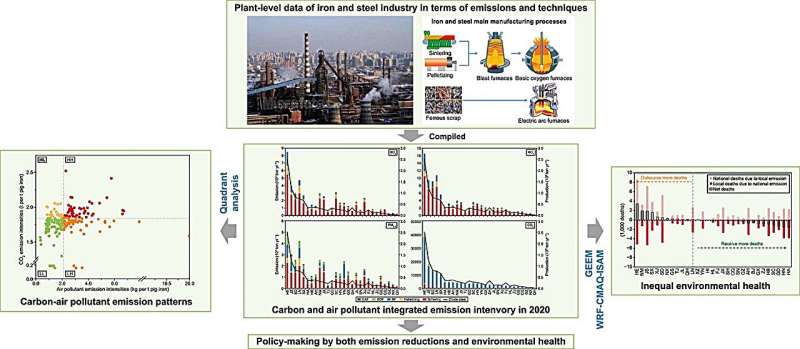Credit: Environmental Science and Ecotechnology (2023). DOI: 10.1016/j.ese.2023.100367
China, the world's top steel producer, is at a crossroads due to its iron and steel industry's heavy CO2 emissions and pollution contribution, spotlighting the urgent need for greener practices. This necessity stems from the industry's impact on air quality and global climate change, driving the push towards adopting sustainable and low-emission technologies to ensure environmental protection and adherence to international climate commitments.
In a recent study published in the journal Environmental Science and Ecotechnology, researchers from the Chinese Academy of Environmental Planning present an in-depth look at the CO2 emissions and health impacts from China's iron and steel sector. Highlighting a critical need for eco-friendly shifts, the study maps out a sustainable transformation strategy to combat climate change and enhance air quality.
The study conducts an exhaustive examination of the CO2 emissions and health impacts linked to China's iron and steel industry, pinpointing sintering processes and blast furnaces as the main culprits of pollution. Through a meticulously crafted emission inventory of 811 enterprises, it uncovers the stark reality of how these emissions amplify PM2.5 concentrations, leading to significant health repercussions, including tens of thousands of premature deaths annually.
Advocating for a shift towards advanced, energy-saving production technologies, the research lays down a strategic roadmap for the industry.
The study found:
- Sintering is the main air pollutant source, while blast furnaces contribute 81% of CO2 emissions.
- ISI is estimated to cause over 59,000 premature deaths in China in 2020.
- 48% of PM2.5-related deaths are due to emissions from Hebei, Jiangsu, Shandong, Shanxi, and Nei Mongol.
- Provinces with high health impact and carbon emissions should implement stricter control measures.
"We have identified key areas where intervention can significantly reduce environmental and health impacts," states Dr. Wenbo Xue, the study's lead researcher. "By focusing on energy-efficient technologies and advanced techniques, along with ultra-low emission standards, we can pave the way for a sustainable future for the iron and steel industry."
This study marks a significant step towards the industry's sustainable transformation. It serves as a valuable reference for policymakers and stakeholders, underlining the importance of integrated efforts in pollution and carbon emission reduction for a healthier, greener future.
More information: Weiling Wu et al, Quantifying China's iron and steel industry's CO2 emissions and environmental health burdens: A pathway to sustainable transformation, Environmental Science and Ecotechnology (2023). DOI: 10.1016/j.ese.2023.100367
Provided by TranSpread
























